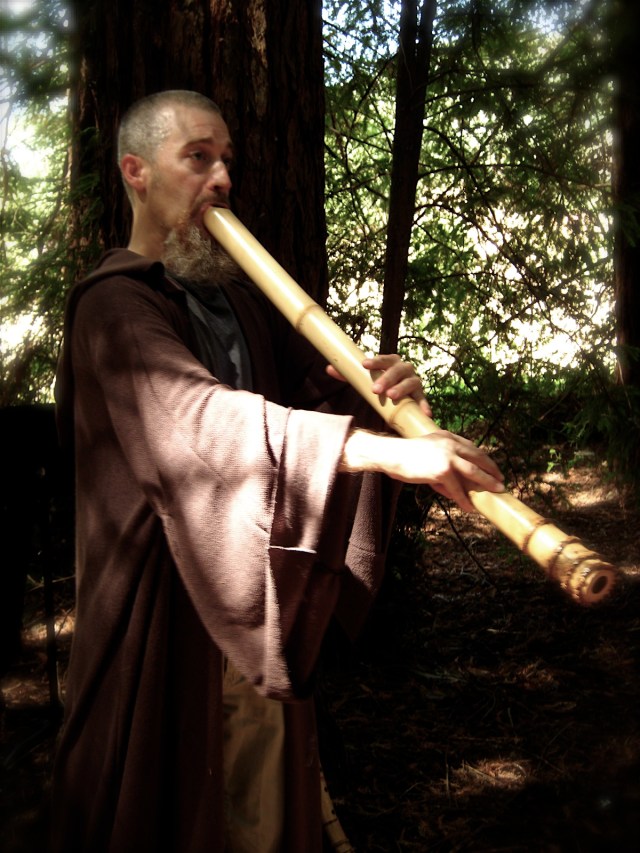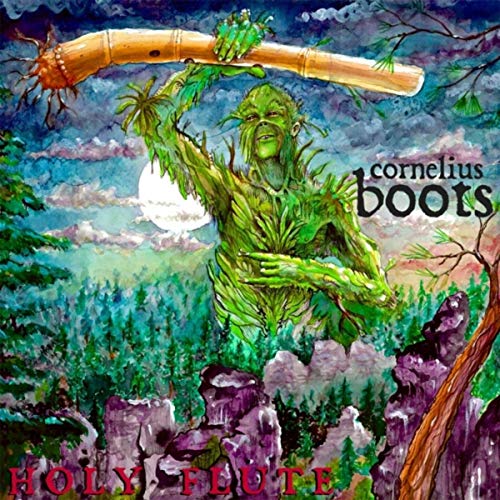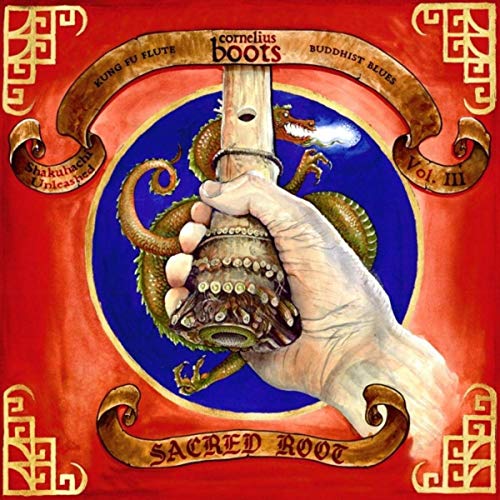
Portrait of composer/performer Cornelius Boots from his website
If one pays any attention to creative music in the Bay Area the name Cornelius Boots will come up with some frequency. He is a good example of the rich cross cultural traditions which have flourished in this area. California was (and is) in many ways the ground zero of east/west collaborations and Boots contributes his unique take on music and on some unusual instruments. He is known for organizing the world’s first Bass Clarinet Quartet named, “Edmund Welles”. He characterizes himself as, “Pied Piper of the nerdy, strange and enlightened.” How California is that?
Boots has released a trilogy, virtually a manifesto, of his take on Shakuhachi, the Japanese bamboo flute, and our current musical/cultural proclivities. In particular he favors the Taimu, described as the “baritone brother” of the shorter, higher pitched shakuhachi which is seen/heard more commonly. The strange breathy sound of this instrument is widely known in traditional Japanese music and it is associated with Zen Buddhist traditions (Boots uses two different shakuhachis in this recording). Here is where I derive my title for this review. What Boots is doing is arguably cultural appropriation. That pejorative epithet is thrown about rather cavalierly these days but what this artist does in this trilogy is to cross the bridge from mere appropriation to incorporation. He has absorbed the traditional aspects of the instrument and is now at a point where he can inject his own musical consciousness into and through this unique instrument giving listeners a perspective heretofore unavailable. That is art.

Shakuhachi Unleashed Vol. I
There is a curious unity to this trilogy of albums which suggests a major reckoning by the composer as he draws musical conclusions filtered through the lens of his experience and the traditions of his chosen instrument. The unique playful cover art (by Nakona MacDonald) is one of the great unifying factors here. In fact these CDs are dense with ideas and are worthy of close scrutiny to reveal their richness and how well integrated they are into this production. Even the numbering of the tracks segregating each disc into a virtual “side A and side B” in the tracklist are a reference and homage to the days of vinyl records. And of course the big unifying factor is the music itself. All the music is the responsibility of Mr. Boots who also sings. The only other noise is made by percussionist Karen Stackpole whose stomping is credited.
This first volume (2016) consists of:
Side A: Darkness
- Blacken the Cursed Sun (Lamb of God)
- Heaven and Hell (Black Sabbath and Dio)
- Purgatory
- Until You Call on the Dark (Danzig)
- Damaged Soul (Black Sabbath)
- No Quarter (Led Zeppelin)
Side B: Salvation
- Hymn to the She Dragon of the Deep
- The Devil Points
- Taste of Nothing
- Year of the Gost God of the Flute
- Generuslu
- Behind the Wall of Sleep (Black Sabbath)

Shakuhachi Unleashed Vol. II
This second disc:
- Run to the Hills (Iron Maiden)
- The Wayward Meteor (Man or Astroman?)
- Obscured by Clouds (Pink Floyd)
- Baby Bear Drinks Tea
- One Brown Mouse (Jethro Tull)
- Green Swampy Water
- Snake Dreams of Dragon
- Sycamore Trees (David Lynch and Angelo Badalamenti)
- Creature Within the Atom Brain (Roky Erikson)
- Shadow of the Wind (Black Sabbath with Dio)
- The Greening of Mount Subasio
- Hung from the Moon (Earth)
- Over the Hills and Far Away (Led Zeppelin)
- Freebird (Lynyrd Skynyrd)

Shakuhachi Unleashed Vol. III
Here now is the latest release:
Side A: Kung Fu Flute
- Chim Chim’s Badass Revenge (Fishbone)
- Fisticuffs (Primus)
- Return and Enter the Dragon (Bruce Lee Movie Themes)
- Death of the Samurai
- Battle Without Honor or Humanity (Kill Bill movie music)
- Big Boss (Bruce Lee movie theme)
- Kung Fu and the Silent Flute (David Carradine theme music)
- Hey Joe (Jimi Hendrix)
- Rebel Rouser (Duane Eddy)
Side B: Buddhist Blues
- Black Earth
- Purple Haze (Jimi Hendrix)
- Shine On You Crazy Diamond Part II (Pink Floyd)
- The Mysteries of Harmony and Focus
- Beautiful Demon
- Shakthamunki
- You’re Gonna Find Your Mistake (James Kimbrough)
- It Hurts Me Too (Elmore James)
- Breathe (Pink Floyd)
There are wide ranging references and playful references like “shakthumunki (shock the monkey)” exist alongside music obviously important to this artist including traditional blues and a curious selection of blues’ baby, rock and roll as well as some very personal compositions. There is much to ponder here. There are references to prog rock, movies, Lovecraft, covers of some familiar tunes. References seem to exist here to beat culture as well as, more prominently, psychedelic culture. But no Grateful Dead? Well, that’s another thing to ponder as we follow the piper who calls us to join him.
[…] Shakuhachi Ecstasy […]
LikeLike